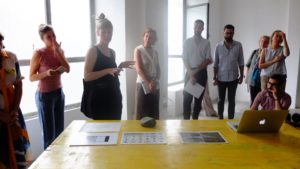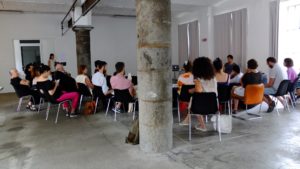The most recent UNIDEE module “Expanded Body #2 – Inhabiting Time” was held from 9th to 16th July at Oasi Zegna and Cittadellarte, in collaboration with Fondazione Zegna. As suggested in the title of the artistic residency, in the course of the week the concept of time was studied and examined in depth in all its aspects. What is time? How do we perceive the flow of time and what is our relationship with it? What is time for a plant? How can we approach the deep time of rocks? What is the relationship between the time of machines, of human beings and of natural cycle? What is free time? What is time in contemporary physics?
The module, curated by Andrea Caretto and Raffaella Spagna, developed along the lines of these questions.
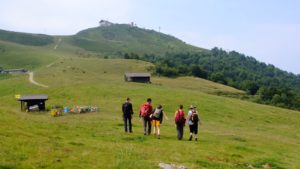

The continuity with last year’s module
The two mentors had already carried out activities in the Piedmontese naturalistic area last year, on the occasion of the workshop “Expanded Body. An immersive exploration of the Oasi Zegna”, held from 26th June to 3rd July 2017. A continuity mentioned by the mentors themselves in the course of the final presentation: “It is the first time we have repeated a similar experience two years running. This year’s module – explained Caretto – was an opportunity to deal with issues we left unexplored last year”. One of the key moments of the residency was in fact this conclusive part, in which the mentors illustrated the peculiarities of the experience and the artists showcased their works and shared personal tales about their week’s activities.
The participants and the guests
Six were the international artists taking part in the module and, like it was for the first edition, they were selected through an open call. They were: Ludwig Berger (1986, Germany/Switzerland), Laura Harrington (1980, United Kingdom), Marit Mihklepp (1985, Estonia/the Netherlands), Enrico Partengo (1985, Italy), Meredith Root-Bernstein (1982, USA/France) and Elisa Storelli (1986, Switzerland/Germany). As usual in the UNIDEE modules, two guests added to the experience of the participants: José D. Edelstein, theoretical physicist and professor in the Department of Particle Physics of the University of Santiago de Compostela, and Marco Giardino, professor of Physical Geography and Geomorphology in the Department of Earth Sciences of the University of Turin. The module also saw the participation of the artist Sara Cattin, selected as a mediator between the artists and Oasi Zegna’s education office, who will have the delicate task to read and interpret the contents elaborated by the participants in the course of the week of residency, in order to formulate proposals for workshops to offer at Oasi Zegna in the future.
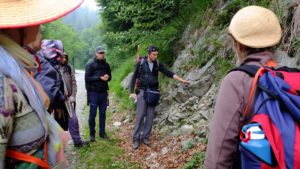
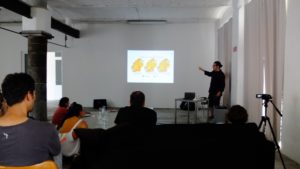
The unfolding of the week
As mentioned, the module was divided in two parts. The first was based in the mountain refuge Alpe Moncerchio (Bielmonte, BI), within Oasi Zegna. This location was the cradle and at the heart of the experience, and it is where the participants, among activities and excursions, experimented with different aspects of the perception of time. Working in close contact with the different environments of the Oasi, the residents, led by the mentors, carried out individual and collective actions, observations and collections of materials useful to elaborate their projects. In the second phase of the module, held in Cittadellarte, the artists developed an individual research revisiting their experience at the Oasi Zegna, which at the end they presented to the public through videos, documents and small installations.
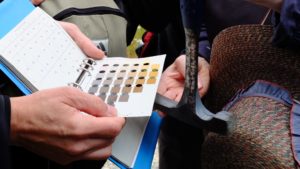
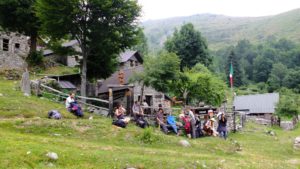
The workbook
The mentors and the residents realized 13 copies of a workbook by hand. Raffaella Spagna told us about the characteristics of this special diary: “It was our spatial-temporal guide to travel around Oasi Zegna. Having already worked in the same area helped us a lot, we could in fact move around without using maps. The workbook, divided in sections, includes texts, images and blank pages to take notes. Here are a few examples of the contents: the ‘physical’ body and the circadian rhythm; an introduction to the relationship between time of the day, organs and Meridians in Chinese natural medicine; a selection of exercises to activate the Meridians; an insert on the theme of chronobiology, discussed by Ernst Zürcher (a forest engineer from the University of Bern) in his speech as a guest of last year’s module. The notebook was the artists’ travelling companion and work tool in the course of the artistic-emotional process taking them through the different temporalities of Oasi Zegna”.
The themes and the comments of the mentors during the final presentation at Cittadellarte
In the course of the final presentation, the mentors highlighted a few peculiarities of the module: “We want to thank Cittadellarte, Anna Zegna and Matteo Ferrario for their support, – started Caretto – the theme of the module was time, an extremely wide subject which we analysed from different perspectives. We started from a reflection on the so-called ‘social acceleration’, one of the most typical phenomenon of our times, and on the forms of alienation deriving from it, and, as a consequence, we structured our programme of exercises according to a different temporality, more respectful of our body’s natural rhythms, suggesting practices of attention and presence. Through the different activities ‘on the field’, we investigated our biological clock, the 24-hour span determining our days, the perception we have of time, the deep time of geology. We opted for a direct physical experience of the natural environment rather than more traditional lessons and reflections on what time is, allowing the artists to get more involved with each other”.
One of the key concepts of the module was in fact the loss of the usual temporal references: “In the first few days we tried to concentrate on each of our natural rhythms – continued the mentors – without ‘synchronizing’ them with watches or other technological devices. In fact, we suggested to the residents not to use technology at all, not even the instruments they usually employ in their artistic practices. This way, each phase of the day developed naturally: we ate when we were hungry, we rested when we were tired; without being dictated to by watches or other factors. The participants agreed, living those days without intermediation, if not with the environment and with the other residents. We thus created a temporary educational community characterized by a great openness toward the other and the context, and a willingness to share knowledge and experiences within the group which we tried to stimulate and facilitate. In conclusion, the temporality generated by our individual personal rhythms has given its fruits: in spite of the many activities, our week at Oasi Zegna concluded in a natural and relaxed way, a harmonic flow which continued even throughout the week at Cittadellarte”.
